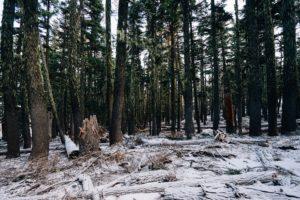Ontario winters can be rough on trees. The heavy snow and ice, the cold, dry winds, the temperature fluctuations towards spring, salt spray… the list of things that can seriously damage trees is long. Your trees require care in the springtime to make sure they overcome this winter damage and go into the new season as healthy as possible. Some of this care might require a professional eye; some of it you can do yourself!
Detecting Winter Tree Damage
You’ll be able to see evidence of many types of damage almost right: broken branches and cracks in the trunk from frost are some of the most obvious. If you notice anything cracking or buckling, wait until the precipitation has cleared off, especially if it’s damaged due to freezing rain. Trying to disturb the branches while they are under heavy snow and ice can lead to serious injury.
But some types of damage might be overlooked by the untrained eye: discoloration in leaves or evergreen needles, and dead branches or canopies aren’t always obvious. Even root heave caused by frost – a situation where the water in the soil expands and contracts quickly, pushing out plants at the roots – might not be noticed until it’s too late.
When the snow has melted and you can take a good look at your tree and the ground around it, do a walk-around and carefully examine every part. If you see anything that strikes you as out-of-the-ordinary, from small cracks in branches and the trunk to odd discolourations, make a note of it. If you suspect it’s bad, or can’t really tell what your situation is, call a trained arborist to check for you.
How to Treat Tree Damage Caused By Winter
Some winter damage is easy to treat. Broken limbs and smaller branches should be removed and cut back to where they intersect with a larger limb or the trunk. If you leave the damage exposed, you’ll be letting infections and insects access to sensitive tissues in the trunk, and they can spread through the tree. This can lead to more drastic, more costly interventions later, or even the death of the tree.

Spring might reveal more subtle problems. As the tree comes out of its dormancy and begins to grow again, you’ll be able to see which branches are budding, and which ones aren’t. If you notice dead areas and parts of the canopy that aren’t coming in to their spring colours, you should have an arborist check it out and make the necessary pruning decisions.
To prune branches, take clean, sharp tool and cut the branch back to the collar of the next live branch, roughly one-quarter inch away from the next living bud. This is, of course, for smaller branches; larger branch removal requires specialized equipment and knowing where the appropriate cuts should be made. If you don’t have safe equipment, call in for professional help!
Road salt is another important thing to take care of, but for many property owners, it’s “out of sight, out of mind” as soon as spring rolls around. Just because you cannot see the salt residue anymore doesn’t mean it isn’t in the soil! When winter ends, take out the hose and wash off the trunk and the soil around the tree.

